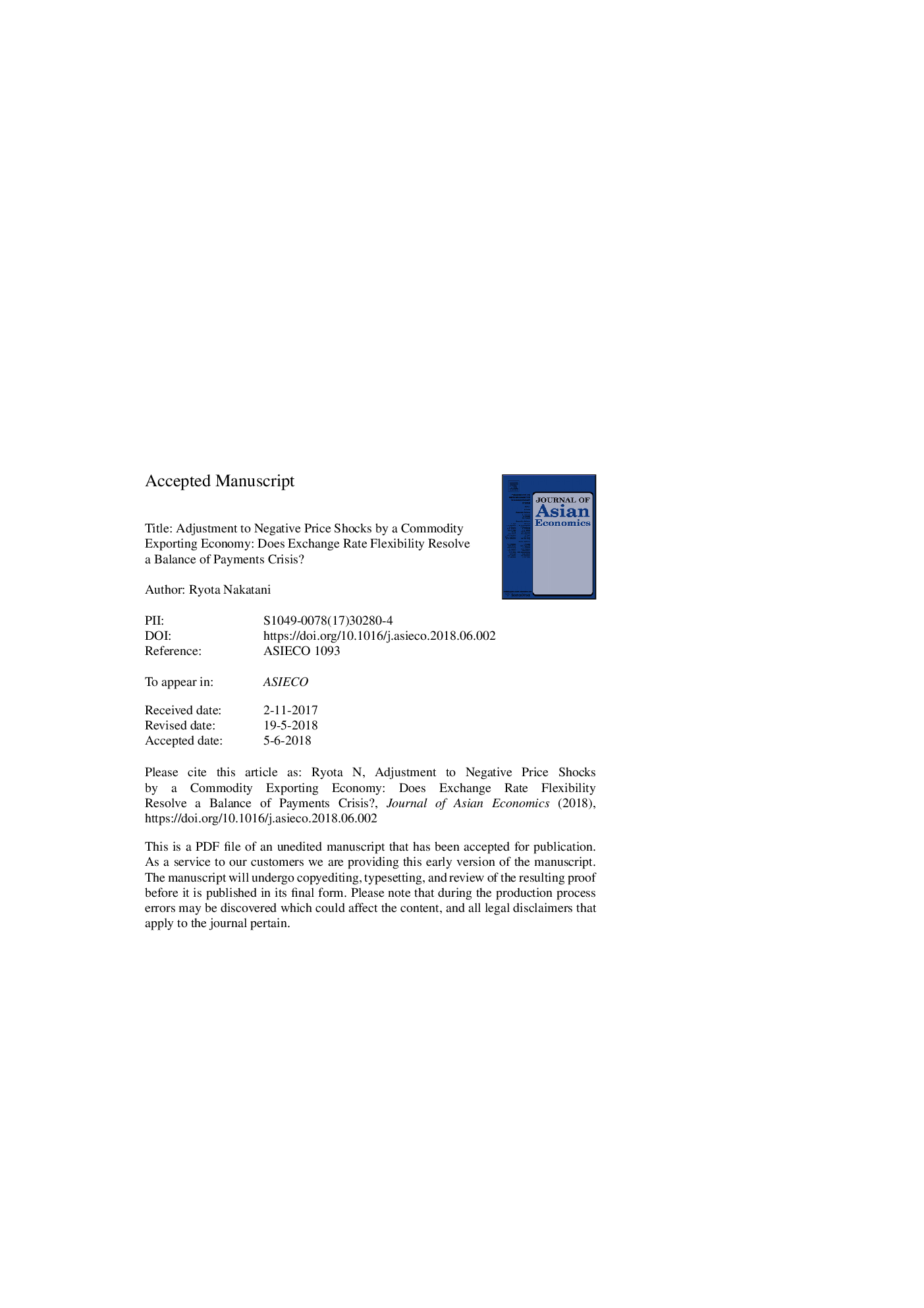| کد مقاله | کد نشریه | سال انتشار | مقاله انگلیسی | نسخه تمام متن |
|---|---|---|---|---|
| 7356372 | 1478235 | 2018 | 33 صفحه PDF | دانلود رایگان |
عنوان انگلیسی مقاله ISI
Adjustment to negative price shocks by a commodity exporting economy: Does exchange rate flexibility resolve a balance of payments crisis?
ترجمه فارسی عنوان
تعدیل به شوکهای منفی قیمت توسط یک اقتصاد صادرات کالا: آیا انعطاف پذیری نرخ ارز مانع بحران پرداخت ها می شود؟
دانلود مقاله + سفارش ترجمه
دانلود مقاله ISI انگلیسی
رایگان برای ایرانیان
کلمات کلیدی
ترجمه چکیده
شوکهای قیمت منفی محصول می تواند بحران های پرداخت های پولی را در اقتصادهای وابسته به منابع ایجاد کند. به عنوان مثال، در مورد پاپوآ گینه نو در پاسخ به شوکهای قیمت کالاها در سال 2014، دولت ها با مداخله در برابر ارزش افزوده پولی واکنش نشان می دهند. ما یک مدل نظری اصلی برای تجزیه و تحلیل تعادلی از تاثیرات پرداخت های شوک قیمت کالاها تحت گزینه رژیم های نرخ ارز: یک رژیم نرخ انعطاف پذیر و یک نرخ ثابت نرخ ارز با مبادله ارز خارجی. به نظر می رسد که برآورده شدن تعادل پرداخت ها به انعطاف پذیری صادرات و واردات با توجه به نرخ ارز بستگی دارد. برای پرونده پاپوآ گینه نو ما تخمین صادرات را برای انواع کالاها (طلا، نقره، مس، روغن، قهوه، کاکائو، کاپا، روغن کاپا، روغن نخل، لاستیک، چای، سیاههها و محصولات دریایی) و همچنین برای واردات نتایج نشان می دهد که وضعیت مارشال-لرنر برای این اقتصاد غنی از منابع رضایتبخش است و به این معنی است که انعطاف پذیری نرخ ارز ممکن است عملی باشد. ما مدل کالیبراسیون ما را برای انجام یک شبیه سازی غیرمستقیم اجرا می کنیم و می بینیم که با یک نرخ ارز انعطاف پذیر، ذخایر خارجی 20 درصد بیشتر از سه سال پس از شوک نسبت به سیاست واقعی ثبات نرخ ارز بود. با توجه به این، ما بر اساس انعطاف پذیری نرخ ارز بیشتر بحث می کنیم.
موضوعات مرتبط
علوم انسانی و اجتماعی
اقتصاد، اقتصادسنجی و امور مالی
اقتصاد و اقتصادسنجی
چکیده انگلیسی
Negative commodity price shocks can induce balance of payments crises in resource dependent economies. Governments often react by intervening against currency depreciation as, for example, in the case of Papua New Guinea in response to the commodity price shocks of 2014. We develop an original theoretical model to analyze the balance of payments impact of a commodity price shock under alternative exchange rate regimes: a flexible rate regime and a fixed rate regime with foreign exchange rationing. The balance of payments consequences are shown to depend on the elasticity of exports and imports with respect to the exchange rate. For the Papua New Guinea case, we estimate export elasticities for a variety of commodities (gold, silver, copper, oil, coffee, cocoa, copra, copra oil, palm oil, rubber, tea, logs, and marine products) as well as for imports. The results indicate that the Marshall-Lerner condition is satisfied for this resource-rich economy, implying that exchange rate flexibility may be practicable. We implement our calibrated model to conduct a counter-factual simulation and find that with a flexible exchange rate, foreign reserves would have been 20 percent higher three years after the shock than they were under the actual policy of exchange rate stabilization. In light of this, we argue the merits of greater exchange rate flexibility.
ناشر
Database: Elsevier - ScienceDirect (ساینس دایرکت)
Journal: Journal of Asian Economics - Volume 57, August 2018, Pages 13-35
Journal: Journal of Asian Economics - Volume 57, August 2018, Pages 13-35
نویسندگان
Ryota Nakatani,
